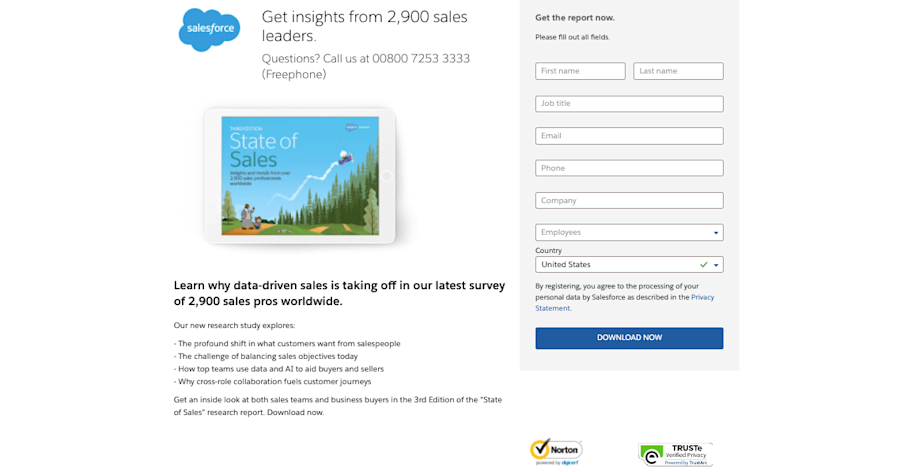The life of a salesperson is often tiresome and sometimes just plain frustrating.
It’s no secret that sales and marketing often butt heads when it comes to qualified leads.
The misalignment between departments can cost your business time and money.
Instead, sales and marketing should be working together. This is done through lead generation and sales prospecting.
While the two terms are often used interchangeably, they’re not the same.
Here, we’ll explain the difference between lead generation and sales prospecting while providing actionable tactics to bridge the gap between sales and marketing teams.
We’ll cover:
What lead generation is
How to improve the lead generation process
What sales prospecting is
Sales prospecting techniques to try
How to align sales and marketing teams to close more deals
Before diving in headfirst, let’s get our feet wet with the basics.
Note: Ready for a sales pipeline that fills itself? Try Leadfeeder free for 14 days.
Leads and prospects are not the same
To say leads and prospects are the same is like saying there’s no difference between a juicy cheeseburger and a veggie burger.
Yes, they’re both “burgers” serving the purpose of fulfilling your hangry cravings.
However, once you take a bite, you’ll notice the difference. A veggie burger is good, but a juicy cheeseburger is great.
You can apply the same analogy to leads and prospects.
Both leads and prospects are a part of the sales process and have shown varying interest levels in a product or service.
A lead is good — it means they’ve shown interest and given their information. However, a prospect is great.
For better context, let’s go over what a lead and prospect are.

What is a lead?
A sales lead is a top-of-the-funnel contact (person or business) who has expressed potential interest in your company’s product or service.
They show interest by providing information in exchange for gated content — or content that requires individuals to fill out a form before they can access said content.
The requested information can range from basics like their name and email, to more exploratory requests, like their job title and company size.
It’s important to note that leads have yet to be qualified. There’s no apparent indicator of whether they suit your ideal buyer persona or they’re interested in buying what you’re selling.
What is a prospect?
Once a lead has met a set of predetermined characteristics, it then becomes a qualified prospect.
These contacts are further down the sales funnel and have a vested interest beyond one-way communication.
Prospects should have an unaddressed business challenge or problem that could be solved more efficiently. You need something you can leverage to promote value.
If they don’t, it’s probably time to disqualify them and save yourself from wasted time and heartache.
Trust me; we’ve all been there.
Don’t make the mistake of thinking a prospect is a closed deal — the person or business has simply met the specified criteria.
This is where sales prospecting comes in, which we’ll get to later.
What is lead generation?
Lead generation is a process used to attract potential customers by driving brand awareness and nurturing relationships to gain contact information.
Typically, lead generation is a marketing function. It’s the first step in the sales process and a long-term strategy for building the sales pipeline.
To put things in perspective, you can think of lead generation like playing the “long game.”
Hear me out.
Did you ever take an unpaid internship because you knew it was a great gig that could catapult your career?
Sure, the whole not getting paid thing is a downer. However, that small step that may have been an inconvenience at the time was something you did in pursuit of the bigger picture.
The long game — if you will.
Examples of business-to-business (B2B) lead generation include:
E-books
Whitepapers
Webinars
Once a contact has given their information, the marketing team can begin the lead nurturing process for those who match your target audience. The outreach at this stage takes a one-to-many approach.
How to improve the lead generation process
1. Nurture the leads
You wouldn’t ask someone to marry you on the first date, would you?
No, you wouldn’t. You’d nurture and build the relationship first.
The same goes for leads.
In sales and marketing, you need to nurture leads at every stage of the sales funnel.
This allows you to send personalized content based on a lead’s actions and stage in the buyer journey.
The most popular example of lead nurturing is creating personalized email marketing campaigns.
2. Develop high-quality, gated content
I briefly touched on gated content earlier in this guide, but wanted to expand upon it here.
Gated content is an effective form of content marketing that can aid lead generation.
It’s an excellent way to capture high-quality leads that you know are interested enough to provide contact information. In exchange, they get a high-value piece of content.
For example, Salesforce requires you to fill out a seven-field form to access the third-edition of its State of Sales report.

However, not all material should be gated, including blog posts or infographics.
These content types are developed for the awareness stage of the buyer journey — where the buyer has just realized a business problem or challenge.
3. Use lead generation software like Leadfeeder
I’m all about working smarter.
Using lead generation software like Leadfeeder can streamline efficiencies and put time back on your schedule.
Leadfeeder’s software identifies anonymous website traffic from decision-makers or businesses who are already visiting your website.

You can also see the exact webpages contacts are looking at to empower more personalized follow-ups.
Leadfeeder can also be set up to automatically update your customer relationship management (CRM) tool when a lead visits again.
What is sales prospecting?
Put simply, sales prospecting is the act of reaching out to interested contacts from a list of leads in search of prospective customers.
The sales team manages sales prospecting. It’s the process that comes after lead generation and involves a one-to-one approach.
Standard outbound sales methods include cold calling and cold emailing, which can work well when used together.
However, focusing on leads that have been pre-heated — or engaged — by the marketing team is more effective.
Why?
Beyond making sense from a logical perspective, focusing time on the hottest leads with pre-established relationships helps move things along the pipeline.
Examples of B2B sales prospecting activities include:
Warm emailing
Warm calling
While this may seem like a simple process, it’s generally the most difficult.
A 2018 inbound marketing study from HubSpot revealed 37 percent of sales reps perceive prospecting as the most challenging part of the sales process.
In fact, 47 percent of North American sales representatives said receiving a prospect response was their number one challenge.

This shouldn’t come as a shock. Today’s buyers are more digitally savvy than ever and expect a personalized experience.
To push past the competition, you’ll have to be more thoughtful in your outreach.
Sales prospecting techniques to try
1. Get social
Social selling is on the rise.
LinkedIn’s 2020 State of Sales report found that the time spent on LinkedIn Learning workshops about “social selling” more than doubled in two months across the globe.
The most popular platforms used by sales teams for social selling are Facebook, LinkedIn, and Twitter.
More than likely, social selling is something you’re already doing without knowing it.
Whenever you share a blog or video content specific to your company on your social channels, you’re doing social selling.
I’ve gone in-depth about this in a previous webinar, but the key is to engage with prospects after they’ve shown interest in the content you’ve shared.
I often find that a salesperson will publish an article or two and call it a day. Don’t be that person.
The point is to interact with potential customers to start two-way communication.
Use your list of qualified leads to find your prospects’ social channels to take things a step further. Answer their related questions and continue warming up those contacts.
2. Become a thought leader
Sadly, there is no magic wand to turn you into a perceived thought leader instantly. Establishing credibility will take time.
The good news is B2B buyers will look for your content once you have developed a rapport.
DemandGen’s 2019 Content Preferences Survey Report shows 95 percent of B2B marketers seek out credible content from industry thought leaders.
You can become an industry thought leader by writing guest blog posts for reputable websites or becoming a speaker at upcoming conferences.
3. Please. Stop. Selling.
I understand why it might sound counterintuitive to tell salespeople not to sell.
Here’s the thing:
There’s a time and a place in the sales funnel to push your product or service — during the prospecting stage is not it. You don’t want to overwhelm your prospect too soon.
Instead, your sole focus should be on driving value for the potential customer and figuring out how your product or service can uniquely meet their needs.
Align sales and marketing to close more deals
A typical sales and marketing workflow can involve a lot of back-and-forths.
Let’s run through an example.
Marketing runs a lead generation campaign and puts together a list of qualified leads. They then share it with the sales team.
The sales team takes those leads to begin the prospecting process. However, after looking closer, they decide the marketing team’s standards did not qualify most of the leads correctly.
The sales team goes back to marketing and asks for new leads.
This leaves the marketing team wondering:
What happened to the “qualified” lists we just gave you?
It’s a never-ending simulation that is costing your business time and money. Marketing and sales alignment is essential to the success of your business.
Here are the best ways to begin the alignment process:
Determine lead requirements: Establish what comprises a marketing qualified lead (MQL) and sales qualified lead (SQL) to eliminate confusion.
Develop a service level agreement (SLA): An SLA is a contract between your sales and marketing team meant to hold both departments accountable. It should clearly outline marketing and sales responsibilities.
Implement a lead scoring system: This assigns a predetermined value to specific actions taken by leads. Once a lead has reached the point threshold, it’s ready to hand off to sales.
Specify the handoff point: Once a lead becomes an MQL, marketing hands it off to the sales team. However, what categorizes a lead as qualified is unique to each business.
Final Thoughts: Lead Generation vs. Sales Prospecting: The Difference
Misaligned marketing and sales teams can waste time and cause leads to go unused. For a successful sales process, both departments must work together.
Marketing can help sales teams speed up the sales cycle through lead generation strategies that focus on higher-quality contacts.
There will be less confusion if you have clearly defined lead qualification criteria, and the marketing-to-sales handoff will go smoother.
Just remember lead generation ≠ sales prospecting.
Note: Ready for a sales pipeline that fills itself? Try Leadfeeder free for 14 days.
Now that you're here
Leadfeeder is a tool that shows you companies that visit your website. Leadfeeder generates new leads, offers insight on your customers and can help you increase your marketing ROI.
If you liked this blog post, you'll probably love Leadfeeder, too.
Sign up







